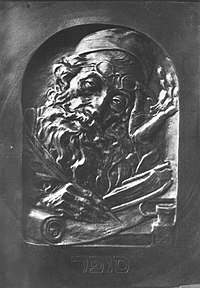Boris Schatz
Boris Schatz (Hebrew: בוריס שץ; Russian: Борис Шац; 23 December 1866 – 23 March 1932) was a Lithuanian Jewish artist and sculptor who settled in Palestine.
After Schatz died, part of his art collection, including a famous self portrait by Dutch Master Jozef Israëls, given to him by the artist, eventually became the nucleus of the Israel Museum.
Antokolsky secured a stipend for Schatz and encouraged him to apply for the St. Petersburg Academy of Art, but the plan to study there did not work out.
[6] In March 1904, Schatz sailed to the United States to oversee the construction of the Bulgarian Pavilion at the Louisiana Purchase Exposition.
Back in Sofia, he declared himself in love with 16-year-old Theodora (Dora) Gabe, later a renowned Bulgarian poet and children's author.
In 1905, heartbroken when she did not return his affection, Schatz left for Berlin, where he stayed with the Zionist illustrator Ephraim Moses Lilien.
Lilien introduced him to Franz Oppenheimer, a supporter of cooperative land settlement in Israel, and Otto Warburg, later president of the World Zionist Organization.
While living on the shore of the Sea of Galilee during the First World War, Shatz wrote a futurist novel entitled The Rebuilt Jerusalem (Yerushalayim Ha-Benuya) in which Bezalel ben Uri, the Biblical architect of the Mishkan appears at the Bezalel School and takes Schatz on a tour of Israel in the year 2018.
In 1895, Schatz accepted an invitation from Prince Ferdinand of Bulgaria to become the official court sculptor and to establish that country's Royal Academy of Art.
[13] The school's stated goals were "to train the people of Jerusalem in crafts, develop original Jewish art and support Jewish artists, and to find visual expression for the much yearned-for national and spiritual independence that seeks to create a synthesis between European artistic traditions and the Jewish design traditions of the East and West, and to integrate it with the local culture of the Land of Israel.” In 1908, the school moved to a permanent home on what became Shmuel Hanagid Street, which allowed more departments to be opened and the scope of activities expanded.
Part of the Boris Schatz Archive is housed in the Information Center for Israeli Art at the Israel Museum, Jerusalem.
The archive also contains a poem by Levin Kipnis, in his handwriting, which had never been published; a postcard written in French from a young Angelica Schatz to her father Boris; a letter written in Yiddish from Boris Schatz to his close friend and administrative assistant, Mordechai Narkis; and a draft of a letter in French from 1925 to Baron Rothschild requesting financial aid for Bezalel.





